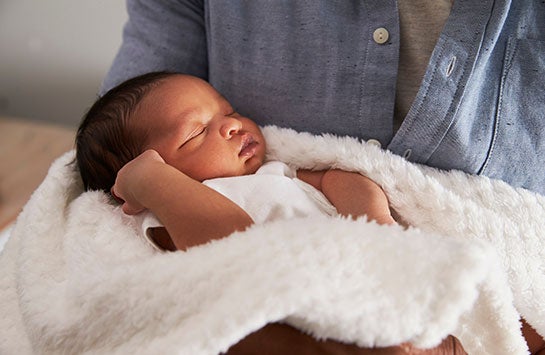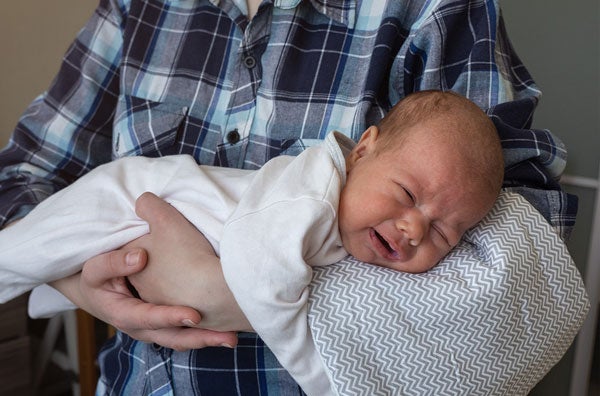Newborn Guide: Newborn Appearance and Behaviors
Newborn Guide: Additional Topics
Topic: Your Baby's Appearance
column
Eyes
You will probably first look at your baby’s eyes. You may notice that both the upper and lower lids are a little swollen, and there may be a small amount of drainage. The swelling is due to the pressure on the face at birth. This swelling and drainage typically clears in several days. The permanent color of the iris is often uncertain until 5-6 months of age for children who will have blue eyes and 2 months for children who will have dark eyes.
Skin
All babies’ skin is more sensitive than adult skin. Therefore, anything you put on the skin may cause a reaction. Use mild soap and plenty of water.
column
Jaundice
The skin is pink to quite red, especially right after birth. A little “jaundice” (yellow color) is usually seen in newborn skin and whites of the eyes by the third day and for a few days thereafter. If your baby’s skin or eyes seem very yellow, please call us.
Flea Bite Rash
Another rash unique to newborn infants is the “flea-bite” rash or “erythema toxicum.” It tends to appear on about the second day and lasts for up to a week. The rash appears as small red circles with a raised white center. Interestingly, they change from hour to hour and may be in different places than you saw them only hours before. No one knows what causes this rash, but it is harmless and resolves by 2-4 weeks of age.
The Newborn Appearance

Hands and Feet
You may notice that your baby’s hands and feet are blue. This is a normal phenomenon caused by your baby’s red blood count being high. The blood count is high so the baby’s red blood cells could “steal” oxygen from your blood prior to birth. Now that your baby is in room air, the blood count will drop, and blueness will disappear.
Vernix
On the skin, you will frequently see the “vernix,” which is the whitish, fatty substance, which gives the skin its softness.
Topic: The Newborn Appearance
column
Lanugo
Your baby may have “lanugo,” fine downy hair that is longest below the nape of the neck. This will disappear during the ensuing months.
Milia
The face, particularly the nose, is often covered with small whitish spots known as “milia,” which represent oil glands.
Stork Bites
Many babies have small, flat, reddish birthmarks over the eyelids, the middle of the forehead, the upper lip, and the nape of the neck (the stork bite). These capillary hemangiomas are superficial blood vessels and usually disappear by 2 years of age.
Breasts
As you look at your baby’s skin, you may notice that his/her breasts are swollen. (Yes this happens in boys too.) This is caused by the passage of female hormones across the mother’s placenta and lasts up to four weeks (longer in breastfed babies). Please call us if you notice redness or tenderness.
column
The Head
If you look at your baby’s head, you will notice two things. The head tends to taper toward the top and back. This is called “molding” and will correct itself in the ensuing days. The scalp is often swollen in this same area from the pressure of the head against the cervix during birth.
Soft Spots
The other thing you may notice is that there are “soft spots” or fontanels in the skull: a large one on the top toward the front, and a small one on the back in the middle. The latter may not be felt in some newborns. These are places where the bones of the skull come together and will disappear with time. The skin over these spots is quite tough, so you needn’t fear scrubbing the scalp in this area.
The Abdomen
The remainder of the umbilical cord is initially moist but dries rapidly and drops off by ten to fourteen days of age. The navel occasionally bleeds slightly when the cord is dropping off, or for a few days afterwards. (Just like a skinned knee losing it’s scab.)
Some navels also have small hernias beneath them, which cause the navel to protrude, especially when the baby cries. These hernias rarely need surgery and most get smaller with time and disappear by 4 years of age.
Topic: Common Newborn Behaviors

Temperament
Each newborn’s personality is unique. You will become the expert at your baby’s personality and temperament. A newborn baby undergoes a number of adjustments in the first few days.
Weight Loss
The first of these is that your baby will initially lose 6-10% of his/her birth weight in the first week. She/he will get back to birth weight by 10 days of age.
Twitches
You will notice frequent muscle twitches and startles. These do not mean he/she is nervous or having convulsions. They represent normal newborn reflexes. Part of this same phenomenon is a quivering chin or tongue when crying.
Topic: Common Newborn Behaviors
column
Sneezes
Many parents notice that their baby sneezes frequently and fear their baby has a cold. This is the way a baby clears his/her nose of dust, lint, and mucous. Unless accompanied by other signs of a cold, sneezing is normal.
column
Hiccups
Hiccups are also frequent in babies and are normal. They should be of no concern.
When to Call University Pediatrics (Click to Expand)
When to Call University Pediatrics
Call us any time of the day or night if your baby has any of the following:
- Rectal temp of 100.4º or greater in a baby 2 months of age or less
- Unusually inactive or quiet
- Excessive crying for no reason
- Vomiting bile or blood
- Repeated vomiting (not just spitting up)
- Breathing hard (using abdominal muscles to breathe)
- Dusky or bluish coloring
If you are experiencing an emergency, you can call us any time of the day or night. If the office is closed, your call will be answered by a nurse who can answer most of your questions and suggest what to do. The nurse can always reach one of our physicians if needed. Our office is open Mon-Fri, 8:30am-5:00pm.
24/7 Phone: (309) 624-9680
Contact University Pediatrics

Next in Our Newborn Guide
Topic: Feeding
Advice on breastfeeding, formula, burping, and more…